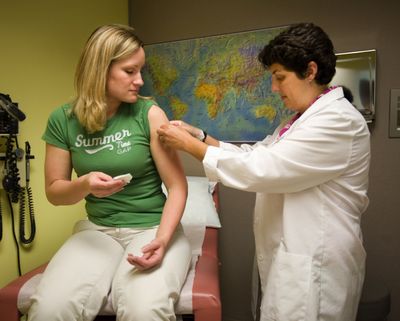HPV-related throat cancers show increase
Q-and-A

It is well known that HPV (human papillomavirus) can lead to deadly cervical cancer in women, but the virus is causing cancer in men as well. Throat cancers caused by HPV are showing up typically in men with little or no history of smoking, said Dr. Kevin J. Cullen, an oncologist who specializes in treating head and neck cancers. Cullen, the director of the University of Maryland’s Marlene and Stewart Greenebaum Cancer Center, talks about the growing cases of HPV-related throat cancers.
Q: Why are we seeing an increase in head and neck cancers related to HPV?
A: The reasons aren’t entirely clear but may be related to changes in sexual practices over time. What is clear is that head and neck cancers due to HPV are rapidly becoming more common than cervical cancer in the U.S. In less than 20 years, there will be four times as much head and neck cancer in men due to HPV than there will be cervical cancer in women.
Q: Are head and neck cancers and cervical cancer caused by the same type of HPV?
A: More than 50 variants or types of HPV have been described. Cervical cancers are most commonly caused by HPV 16, but a significant number are caused by HPV 18 and less frequently by other types. That is why the most widely used vaccine is designed to immunize against HPV 16, as well as HPV 6 and 11 and 18. In contrast, almost all head and neck cancers due to HPV are caused by type 16.
Q: What types of patients are being diagnosed with this type of cancer?
A: The typical patients are otherwise healthy men in their late 40s or early 50s who have little or no history of tobacco use. They are also much more likely to be white than other races.
Q: What are the symptoms of head and neck cancers related to HPV?
The first manifestation is usually a painless lump in the neck. Less frequently, the patient will notice a mass in the tonsil or the base of the tongue which may cause pain or interfere with swallowing. The symptoms are the same as in patients whose cancers are not HPV-related.
Q: Because this is a newer phenomenon, are doctors catching the cancers in early enough stages to treat it?
A: In fact, because these cancers tend to grow fairly rapidly once they develop, patients are more likely to have advanced disease at the time of diagnosis.
Q: What does treatment entail?
A: These cancers are usually treated with a combination of chemotherapy and radiation. Typically, the radiation treatment is given once a day for six or seven weeks, with chemotherapy given at the beginning, middle and end of treatment. The most widely used chemotherapy is cisplatin, which is also used in the treatment of lung cancer and other tumors.
Q: Are most people surviving these cancers?
A: Yes, the cure rate is very high. In patients who have never smoked, the cure rate is over 90 percent. Our research and studies by other groups have found that head and neck cancer patients who test positive for HPV have much better survival rates than patients who don’t have the virus. We found a striking difference in prognosis between patients who are HPV-positive and those who are HPV-negative. In blacks, the HPV infection rate tends to be very low, and as a result, they also have poorer survival rates for head and neck cancer.
Q: What are the worst cases of the disease you have seen?
A: Despite the high cure rate, in some cases the cancer can come back and it can be fatal. We certainly have seen that, and it is tragic.
Q: How can we prevent HPV-related cancers?
A: This disease is highly preventable. Every young man and woman between the ages of 13 and 23 should be vaccinated for HPV. The vaccine not only protects women against cervical cancer but more recent studies demonstrate it prevents oral infection with HPV and so will protect both men and women against oral cancers caused by the virus.